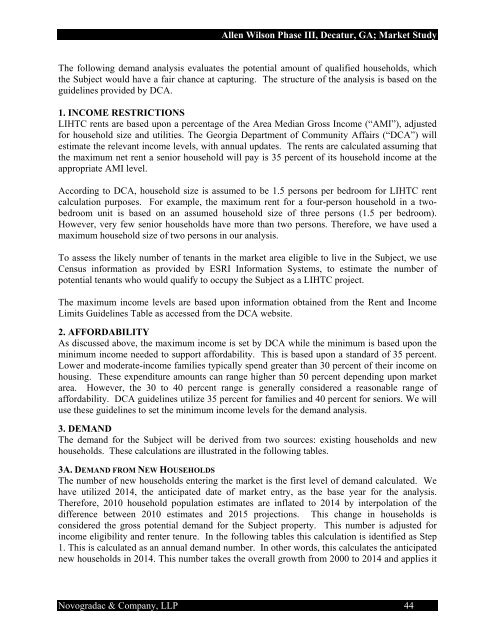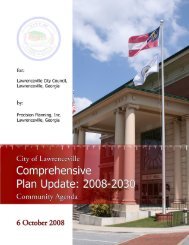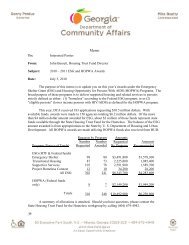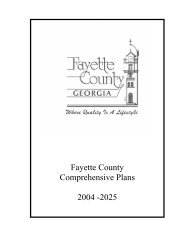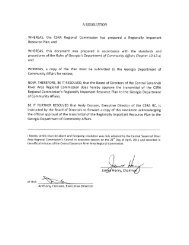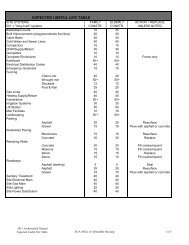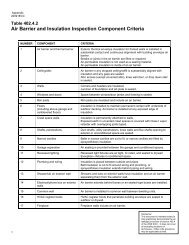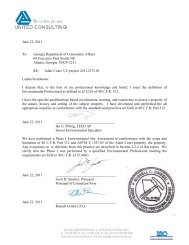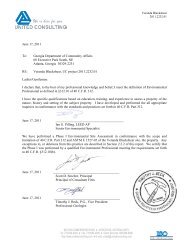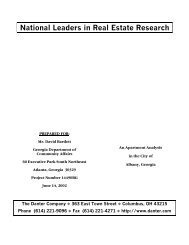a market conditions and project evaluation summary of - Georgia ...
a market conditions and project evaluation summary of - Georgia ...
a market conditions and project evaluation summary of - Georgia ...
Create successful ePaper yourself
Turn your PDF publications into a flip-book with our unique Google optimized e-Paper software.
Allen Wilson Phase III, Decatur, GA; Market Study<br />
The following dem<strong>and</strong> analysis evaluates the potential amount <strong>of</strong> qualified households, which<br />
the Subject would have a fair chance at capturing. The structure <strong>of</strong> the analysis is based on the<br />
guidelines provided by DCA.<br />
1. INCOME RESTRICTIONS<br />
LIHTC rents are based upon a percentage <strong>of</strong> the Area Median Gross Income (“AMI”), adjusted<br />
for household size <strong>and</strong> utilities. The <strong>Georgia</strong> Department <strong>of</strong> Community Affairs (“DCA”) will<br />
estimate the relevant income levels, with annual updates. The rents are calculated assuming that<br />
the maximum net rent a senior household will pay is 35 percent <strong>of</strong> its household income at the<br />
appropriate AMI level.<br />
According to DCA, household size is assumed to be 1.5 persons per bedroom for LIHTC rent<br />
calculation purposes. For example, the maximum rent for a four-person household in a twobedroom<br />
unit is based on an assumed household size <strong>of</strong> three persons (1.5 per bedroom).<br />
However, very few senior households have more than two persons. Therefore, we have used a<br />
maximum household size <strong>of</strong> two persons in our analysis.<br />
To assess the likely number <strong>of</strong> tenants in the <strong>market</strong> area eligible to live in the Subject, we use<br />
Census information as provided by ESRI Information Systems, to estimate the number <strong>of</strong><br />
potential tenants who would qualify to occupy the Subject as a LIHTC <strong>project</strong>.<br />
The maximum income levels are based upon information obtained from the Rent <strong>and</strong> Income<br />
Limits Guidelines Table as accessed from the DCA website.<br />
2. AFFORDABILITY<br />
As discussed above, the maximum income is set by DCA while the minimum is based upon the<br />
minimum income needed to support affordability. This is based upon a st<strong>and</strong>ard <strong>of</strong> 35 percent.<br />
Lower <strong>and</strong> moderate-income families typically spend greater than 30 percent <strong>of</strong> their income on<br />
housing. These expenditure amounts can range higher than 50 percent depending upon <strong>market</strong><br />
area. However, the 30 to 40 percent range is generally considered a reasonable range <strong>of</strong><br />
affordability. DCA guidelines utilize 35 percent for families <strong>and</strong> 40 percent for seniors. We will<br />
use these guidelines to set the minimum income levels for the dem<strong>and</strong> analysis.<br />
3. DEMAND<br />
The dem<strong>and</strong> for the Subject will be derived from two sources: existing households <strong>and</strong> new<br />
households. These calculations are illustrated in the following tables.<br />
3A. DEMAND FROM NEW HOUSEHOLDS<br />
The number <strong>of</strong> new households entering the <strong>market</strong> is the first level <strong>of</strong> dem<strong>and</strong> calculated. We<br />
have utilized 2014, the anticipated date <strong>of</strong> <strong>market</strong> entry, as the base year for the analysis.<br />
Therefore, 2010 household population estimates are inflated to 2014 by interpolation <strong>of</strong> the<br />
difference between 2010 estimates <strong>and</strong> 2015 <strong>project</strong>ions. This change in households is<br />
considered the gross potential dem<strong>and</strong> for the Subject property. This number is adjusted for<br />
income eligibility <strong>and</strong> renter tenure. In the following tables this calculation is identified as Step<br />
1. This is calculated as an annual dem<strong>and</strong> number. In other words, this calculates the anticipated<br />
new households in 2014. This number takes the overall growth from 2000 to 2014 <strong>and</strong> applies it<br />
Novogradac & Company, LLP 44


